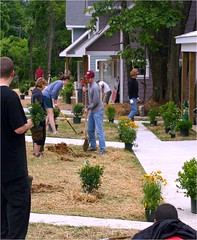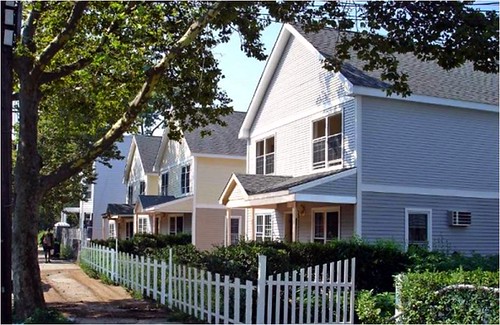Principles of sustainable housing, from the Smart Growth Network

Posted June 9, 2010 at 1:25PM
'Sustainable' is one of those words that means slightly different things to different people. As someone who spoke before me at a forum yesterday said, for example, calling a marriage 'sustainable' isn't saying much good. The Smart Growth Network, a diverse public/private/nonprofit partnership interested in land use, recently undertook a crack at defining the term when it comes to housing, and I think they/we did a decent job of at least laying out the basic principles:
“Housing – its location and manner of construction – dramatically affects the lives of its occupants. It impacts residents’ educational and social opportunities, ability to have an active and healthy lifestyle, financial security, and environmental footprint. Our nation’s approach to housing also impacts our nation’s ability to respond to an aging and more diverse population, to increase our economic competitiveness, to reduce our dependence on oil, to enhance the overall livability of existing communities, and to responsibly grow in a manner that creates better environmental and climate outcomes.
 “Between now and 2050, as the nation approaches a total projected population of 420 million people, it is projected that roughly 89 million new and replaced homes will be constructed. At the same time, state and local governments are developing greenhouse gas reduction goals for 2050 that will be dramatically affected by how and where new growth occurs. These challenges present an opportunity to rethink our conventional approach to housing, and move towards a more sustainable approach – one that would better reflect the true cost of housing, foster healthy and walkable communities, and yield better outcomes for community residents, our neighborhoods, the economy, and the environment.
“Between now and 2050, as the nation approaches a total projected population of 420 million people, it is projected that roughly 89 million new and replaced homes will be constructed. At the same time, state and local governments are developing greenhouse gas reduction goals for 2050 that will be dramatically affected by how and where new growth occurs. These challenges present an opportunity to rethink our conventional approach to housing, and move towards a more sustainable approach – one that would better reflect the true cost of housing, foster healthy and walkable communities, and yield better outcomes for community residents, our neighborhoods, the economy, and the environment.
“The Smart Growth Network believes that sustainable housing is characterized by the following principles and characteristics:
- Housing that is located on sites near transit, job opportunities, commercial centers, schools, open space, recreation and public and community services.
- Housing that is made more affordable through strengthened connections to viable transportation alternatives and allows households to dramatically reduce the cost of transportation to and from work, retail, and recreation.
- Housing that makes use of previously developed land and existing buildings and infrastructure (e.g., water/sewer lines) through rehabilitation and infill development.

- Housing that is compact and uses green building materials and techniques to reduce energy consumption associated with transportation and indoor climate, water use, and stormwater runoff.
- Housing that is sited and/or designed to be resilient to natural hazards such as flooding, earthquakes, and sea level rise.
- Housing that optimizes the health and safety of its occupants through design and location that protects indoor air quality, increases accessibility, and minimizes potential injuries.
- Housing that is characterized by: a mix of incomes, sizes, and housing types to meet a range of household sizes, resident ages and income levels; does not differentiate income level through building design, location and availability, and is designed to add value to the community.
- Housing that is part of a holistic community development strategy to create sustainable communities and revitalized neighborhoods that feature job creation, transit accessibility, commercial corridor redevelopment, educational opportunities, and community and human services.
 “There is a role for all levels of private, public, and nonprofit sector leadership to implement this approach. This includes the HUD-DOT-EPA Partnership for Sustainable Communities which has the potential to align federal resources, and support state, regional, and local governments to create the types of communities characterized by the principles above.” (Emphasis is mine.)
“There is a role for all levels of private, public, and nonprofit sector leadership to implement this approach. This includes the HUD-DOT-EPA Partnership for Sustainable Communities which has the potential to align federal resources, and support state, regional, and local governments to create the types of communities characterized by the principles above.” (Emphasis is mine.)
These are principles well worth advocating in all relevant forums, and NRDC is proud to be associated with them.
The Smart Growth Network was formed in 1996 by the US Environmental Protection Agency and several non-profit and government organizations (including NRDC) concerned about the need for new ways to grow that boost the economy, protect the environment, and enhance community vitality. The Network's 43 partners include such diverse entities as the Urban Land Institute, National Association of Realtors, NOAA, US Forest Service, Trust for Public Land, Enterprise Community Partners, International City-County Managers Association, and National Trust for Historic Preservation (list of SGN partners here). The statement on housing was led by Julia Seward of the Local Initiatives Support Corporation.
Move your cursor over the images for credit information.
